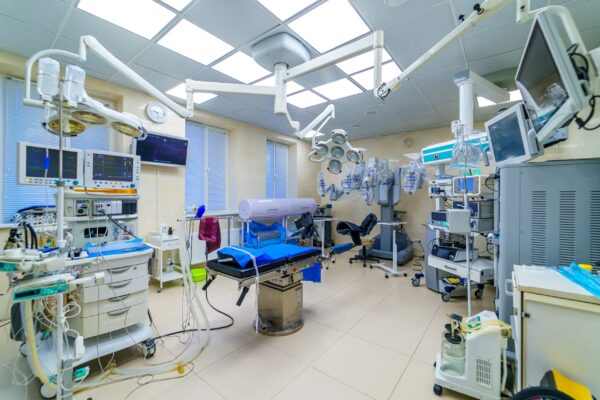We’d like to give you the example of the perfect automation adoption attitude. There is an industry that parallels the challenges facing traditional product manufacturing. They adopt both mechanical and IOT automation with complete lack of hesitation. And when they do adopt automated processes, the media cheers them on.
Healthcare: Manufacturing’s Mirror
Our healthcare industry may work in the confines of medicines, surgeries, and appointments, but they mirror the challenges and response strategies of manufacturers in startling ways.
Labor Shortages BEFORE the pandemic
In 2019 , the U.S Health Resources & Services Administration estimated that primary care physicians fell short of minimum filled positions by 13,758 with a disproportionate number of current physicians at near retirement. Just like manufacturers, the medical field experienced labor shortages at every level of healthcare. We’re comparing doctors, nurses, pharmacists, technicians, and support staff to manufacturing labor, but the same article topics cropped up in both fields; a lack of interest, difficulty attracting skilled labor or workers with the right certifications and training, and a large population of near retiring workers with specialized skills.
Limited Remote Options
In the same way a worker can’t take the production line home with them, medical professionals have responsibilities that cannot be replicated away from direct contact with their patients. Even after employing tools like virtual check-ups, electronic medical record systems (EMR), and automated medicine dispensing cabinet machines (ADS), treating a patient requires in person assessment, treatment, and hands on care. Both manufacturers and healthcare workers gained essential worker status during the pandemic not only because of how integral their professions were to America, but because their only options for facing quarantine restrictions was to keep working in person or shut down.
Post Pandemic Labor Crisis
Both the medical field and the manufacturing field are suffering a full-blown labor crisis in the wake of the pandemic. With the aforementioned limited remote options, both professions awakened to the great resignation at similar rates for the same reasons: less workers, working longer hours, a high stress environment, exposure to COVID-19, and burnout. Both fields are facing serious concerns that the labor that quit, pivoted, or retired may never come back.
Automated Machine Adoption
When looking to upgrade speed, accuracy, quality, and consistency, both the medical and manufacturing industry employ robotics and automated machines to update their ability to complete their tasks. Custom industrial machines automate packaging, palletizing, adhesive dispensing, assembly, cutting, screwing, high speed CNC machining, and more. Modern pharmacies employ advanced pick and place machines to select medications from pharmacies, they use Automated Dispensing System robots to dispense medications for patients, automate plasma isolation, and even use complex compounding medication machines for precision mixture and packaging of multidose injections. Both industrial and medical custom machines can be built from a library of compartmentalized automated modules for quicker, smarter integration.
Automated IOT Software Adoption
Both the medical field and manufacturers rely on software, interconnectivity, and remote network monitoring to upgrade their efficiency. Automated machinery in an industrial manufacturing plant benefits from advanced vision systems, sensors, data monitoring, and AI assisted production lines. Medical professionals rely on electronic medical record software complex enough to auto calculate doses, track patient records between different hospital networks and territories, and automatically alert medical staff for health emergencies and warnings. Custom control devices (see our NodeUDesign Semi Custom Hardware products) can manage the functions of a network of different machine models of varying ages, and remote maintenance can detect, monitor, and fix issues without being on site for both industrial and medical automation.
An Unsatisfying Disparity
We have these two industries, both modeling identical challenges, both modeling identical automated solutions to those challenges, and both seeing the same types of benefits from automated solutions.
Where are the articles that say Automated Dispensing Cabinets, machines that automatically dispense medicines in hospital wards, are stealing the jobs of pharmacists?
Where are the YouTube thought leaders proposing life hacks to keep your pen and paper filing cabinets instead of upgrading your practice to an electronic medical records system (EMR)?
Why aren’t there politicians demonizing automatic compounding medication machines as unsafe, untrustworthy, and unfaithful to American clean room technicians?
At DEVELOP LLC we wish we could tell you that there were practical reasons why it makes more sense to publicly trust medical automation than manufacturing automation, but the differences boil down to superficial optics. The average person accepts rational arguments for making the medical profession safer, more efficient, and more transparent with automated solutions more than they are willing to accept these solutions for manufacturers based mostly on familiarity. Join us in Part 2: Industrial Automation needs Healthcare’s PR Firm, where we will further explore how differently Automation is treated in the media versus healthcare. But you don’t have to wait! Tell us more about your project, schedule a virtual meeting, or call (262) 622-6104 to learn how you can improve your production outcomes with responsible automated integration.
Authors:
Sean McKittrick and Matt Moseman

